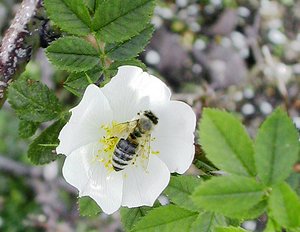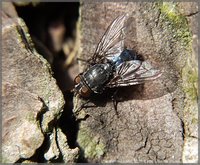Insect
|
|
Insects are invertebrate animals of the Class Insecta, the largest and (on land) most widely distributed taxon within the Phylum Arthropoda. Insects comprise the most diverse group of animals on the earth, with over 800,000 species described—more than all other animal groups combined. Insects may be found in nearly all environments on the planet, although only a small number of species have adapted to life in the oceans where crustaceans tend to predominate. There are approximately 5,000 dragonfly species, 2,000 praying mantis, 20,000 grasshopper, 170,000 butterfly and moth, 120,000 fly, 82,000 true bug, 350,000 beetle, and 110,000 bee and ant species. The study of insects is called entomology.
| Contents |
Relationship to other arthropods
A few smaller groups with similar body plans, such as springtails (Collembola), are united with the insects in the Subphylum Hexapoda. The true insects (that is, species classified in the Class Insecta) are distinguished from all other arthropods in part by having exposed mouthparts and eleven (11) abdominal segments. Most species, but by no means all, have wings as adults. Terrestrial arthropods, such as centipedes, millipedes, scorpions and spiders, are sometimes confused with insects due to the fact that both have similar body plans, sharing (as do all arthropods) a jointed exoskeleton.
Morphology and development
Insects range in size from less than a millimeter to over 18 centimeters (some walkingsticks) in length. Insects possess segmented bodies supported by an exoskeleton, a hard outer covering made mostly of chitin. The body is divided into a head, a thorax, and an abdomen. The head supports a pair of sensory antennae, a pair of compound eyes, and a mouth. The thorax has six legs (one pair per segment) and wings (if present in the species). The abdomen has excretory and reproductive structures.
Insects have a complete digestive system. That is, their digestive system consists basically of a tube that runs from mouth to anus, contrasting with the incomplete digestive systems found in many simpler invertebrates. The excretory system consists of Malpighian tubules for the removal of nitrogenous wastes and the hindgut. At the end of the hindgut, insects are able to reabsorb water along with potassium and sodium ions. Therefore, insects don't usually excrete water with their feces, a fact which allows them to store water in the body. This process of reabsorption enables them to withstand hot, dry environments.

A- Head B- Thorax C- Abdomen
1. antenna 2. ocelli low
3. ocelli hight
4. compound eye
5. brain (cerebral ganglia)
6. prothorax
7. dorsal artery
8. tracheal tubes (trunk with spiracle)
9. mesothorax
10. metathorax
11. first wing
12. second wing
13. mid-gut (stomach)
14. heart
15. ovary
16. hind-gut (intestine, rectum & anus)
17. anus
18. vagina
19. nerve chord (abdominal ganglia)
20. Malpighian tubes
21. pillow
22. claws
23. tarsus
24. tibia
25. femur
26. trochanter
27. fore-gut (crop, gizzard)
28. thoracie ganglion
29. coxa
30. salivary gland
31. subesophageal ganglion
32. mouthparts
Most insects have two pairs of wings located on the second and third thoracic segments. Insects are the only invertebrate group to have developed flight, and this has played an important part in their success. The winged insects, and their secondarily wingless relatives, make up the Pterygota. Insect flight is not very well understood, relying heavily on turbulent atmospheric effects. In more primitive insects it tends to rely heavily on direct flight muscles, which act upon the wing structure. More advanced flyers, which make up the Neoptera, generally have wings that can be folded over their back, keeping them out of the way when not in use. In these insects, the wings are powered mainly by indirect flight muscles that move the wings by stressing the thorax wall. These muscles are able to contract when stretched without nervous impulses, allowing the wings to beat much faster than would be otherwise possible.
Insects use tracheal respiration in order to transport oxygen through their bodies. Openings on the surface of the body called spiracles lead to the tubular tracheal system. Air reaches internal tissues via this system of branching trachea. The circulatory system of insects, like that of other arthropods, is open: the heart pumps the hemolymph through arteries to open spaces surrounding the internal organs; when the heart relaxes, the hemolymph seeps back into the heart.
Insects hatch from eggs, and undergo a series of moults as they develop and grow in size. This manner of growth is necessitated by the exoskeleton. Moulting is a process by which the individual escapes the confines of the exoskeleton in order to increase in size, then grows a new outer covering. In most types of insects, the young, called nymphs, are basically similar in form to the adults (an example is the grasshopper), though wings are not developed until the adult stage. This is called incomplete metamorphosis. Complete metamorphosis distinguishes the Endopterygota, which includes many of the most successful insect groups. In these species, an egg hatches to produce a larva, which is generally worm-like in form. The larva grows and eventually becomes a pupa, a stage sealed within a cocoon or chrysalis in some species. In the pupal stage, the insect undergoes considerable change in form to emerge as an adult, or imago. Butterflies are an example of an insect that undergoes complete metamorphosis.
Behaviour
Many insects possess very refined organs of sense. In some cases, their senses can be more capable than humans. For example, bees can see in the ultraviolet] spectrum, and male moths have a specialized sense of smell that enables them to detect the pheromones of female moths over distances of many kilometers.
Social insects, such as the ant and the bee, are the most familiar species of eusocial animal. They live together in large well-organized colonies that are so tightly integrated and genetically similar the colonies are sometimes considered superorganisms.
Roles in the environment and in human society
Many insects are considered pests by humans, because they transmit diseases (mosquitos, flies), damage structures (termites), or destroy agricultural goods (locusts, weevils). Many entomologists are involved in various forms of pest control, often using insecticides, but more and more relying on methods of biocontrol.
Although pest insects attract the most attention, many insects are beneficial to the environment and to humans. Some pollinate flowering plants (for example wasps, bees, butterflies, ants). Pollination is a trade between plants which need to reproduce, and pollinators which receive rewards of nectar and pollen. A serious environmental problem today is the decline of populations of pollinator insects, and a number of species of insects are now cultured primarily for pollination management in order to have sufficient pollinators in the field, orchard or greenhouse at bloom time.
Insects also produce useful substances such as honey, wax, lacquer or silk. Honeybees, (pictured above) have been cultured by humans for thousands of years for honey, although contracting for crop pollination is becoming more significant for beekeepers. The silkworm has greatly affected human history as silk-driven trade established relationships between China and the rest of the world. Fly larvae (maggots) were formerly used to treat wounds to prevent or stop gangrene, as they would only consume dead flesh. This treatment is finding modern usage in some hospitals.
In some parts of the world, insects are used for human food, (Entomophagy), while being a taboo in other places. There are proponents of developing this use to provide a major source of protein in human nutrition. Since it is impossible to entirely eliminate pest insects from the human food chain, insects already are present in many foods, especially grains. Most people do not realize that food laws in many countries do not prohibit insect parts in food, but rather limit the quantity. According to cultural materialist anthropologist Marvin Harris, the eating of insects is taboo in cultures that have protein sources that require less work like farm birds or cattle.
Many insects, especially beetles, are scavengers, feeding on dead animals and fallen trees, recycling the biological materials into forms found useful by other organism's. The ancient Egyptians adored beetles and represented them as scarabeums.
Although mostly unnoticed by most humans, arguably the most useful of all insects are 'insectivores', those that feed on other insects. Many insects, such as grasshoppers can potentially reproduce so fast that they could literally bury the earth in a single season. However there are hundreds of other insect species that feed on grasshopper eggs, and some that feed on grasshopper adults. This role in ecology is usually assumed to be primarily one of birds, but insects, though less glamorous, are much more significant. For any pest insect one can name, there is a species of wasp that is either a parasitoid or predator upon that pest, and plays a significant role in controlling it.
Human attempts to control pests by insecticides can backfire, because important, but unrecognized insects already helping to control pest populations, are also killed by the poison, leading eventually to population explosions of the pest species.
Fossils and evolution
The relationships of insects are unclear. Although traditionally grouped with millipedes and centipedes, evidence has emerged favoring a relationship with the crustaceans. Insects first appear in the fossil record during the Carboniferous age, about 350 million years ago. Types included several orders now extinct, and some insects larger than any living today. Little is known about the origin of insect flight, since the earliest winged insects appear to be capable fliers. Wings themselves are now thought to be highly modified gills, and some insects had an additional pair of winglets attaching to the first segment of the thorax, for a total of three pairs.
The Permian, around 270 million years, saw the development of most extant orders; many of these groups became extinct. The remarkably successful hymenopterans appeared in the Cretaceous but achieved their diversity more recently, in the Cenozoic.
Many modern insect genera developed during the Cenozoic; from this period on we find insects preserved in amber, often in perfect condition and easily compared with modern species. The study of fossilized insects is called paleoentomology.
Clipart and Animal Pictures
- Clipart (https://classroomclipart.com/image/category/clipart.htm)
- Animal Clipart (https://classroomclipart.com/image/category/animal-clipart.htm)
- Animal Animated Clipart (https://classroomclipart.com/clipart/Animations/Animals.htm)
- Pictures of Animals (https://classroomclipart.com/image/category/animal-photos.htm)
- Amphibian Clip Art, Pictures and Photogaphs (https://classroomclipart.com/image/category/amphibian-clipart.htm)
- Farm Animal Clip Art, Pictures and Photographs (https://classroomclipart.com/image/category/farm-animal-clipart.htm)
- Mammal Clip Art, Pictures and Photographs (https://classroomclipart.com/image/category/mammal-clipart.htm)
- Marine Animal Clip Art, Pictures and Photographs (https://classroomclipart.com/image/category/marine-life-clipart.htm)
- Reptile Clip Art, Pictures and Photographs (https://classroomclipart.com/image/category/reptile-clipart.htm)
- Spider Clip Art, Pictures and Photographs (https://classroomclipart.com/image/category/spider-clipart.htm)
- Pictures of Insects (http://classroomclipart.com/clipart/Animals/Insects.htm)




